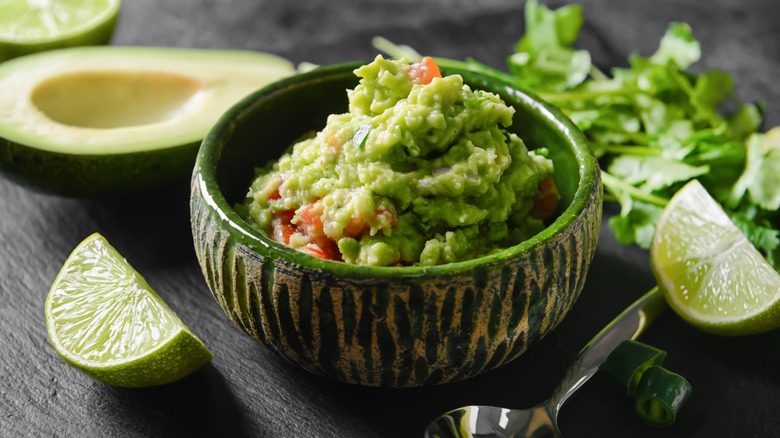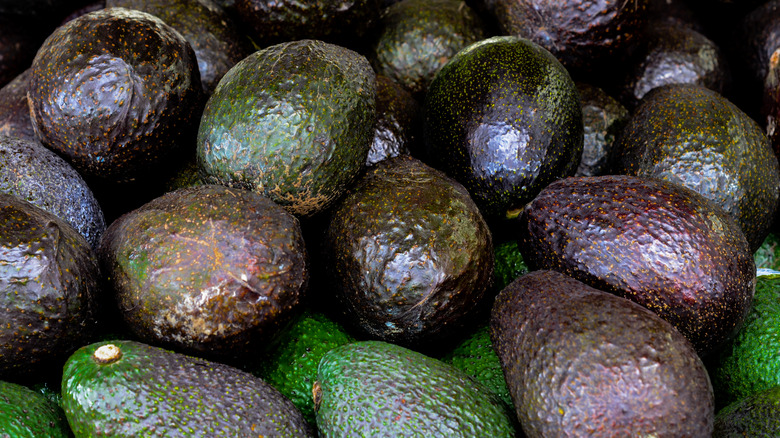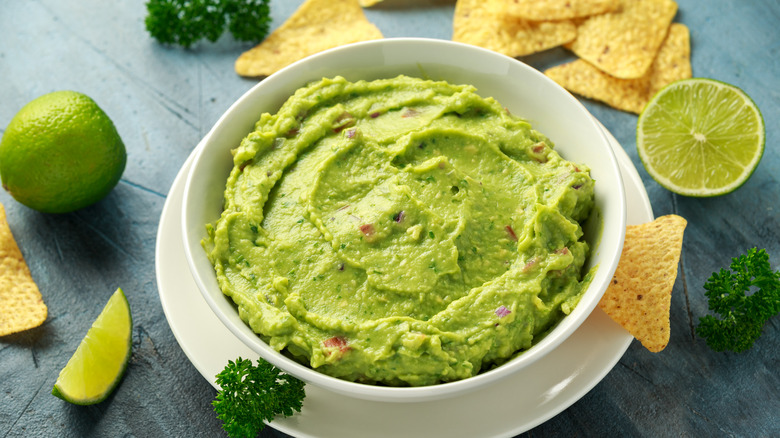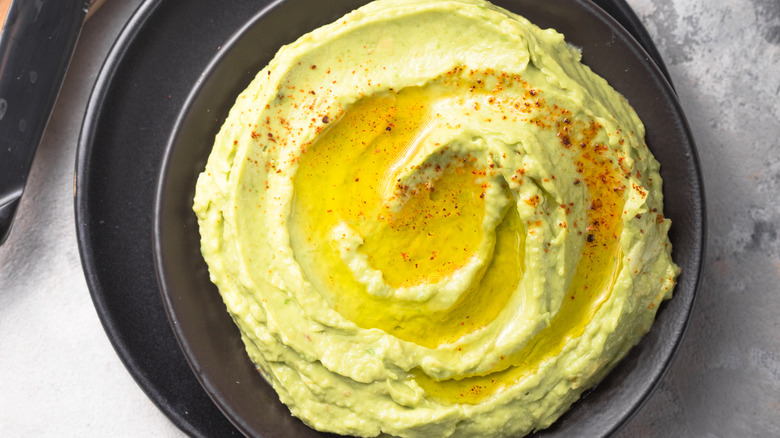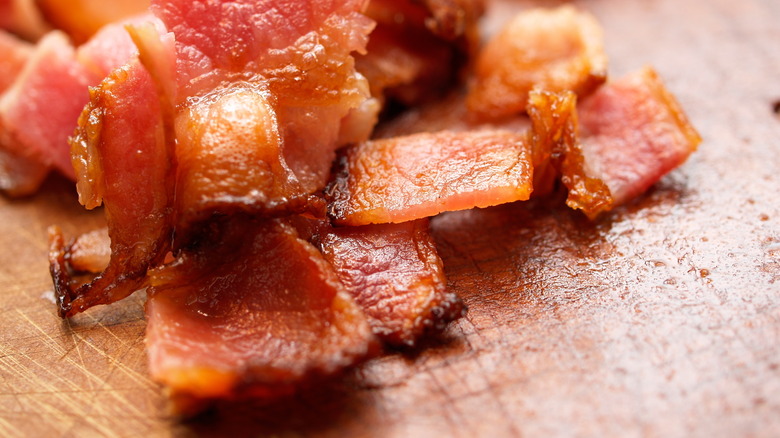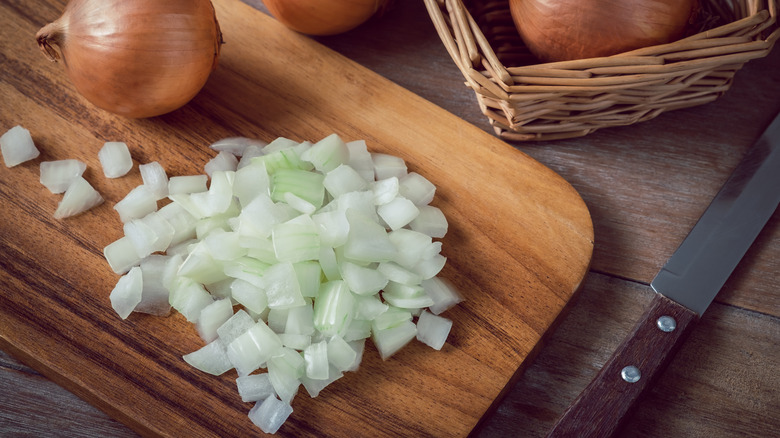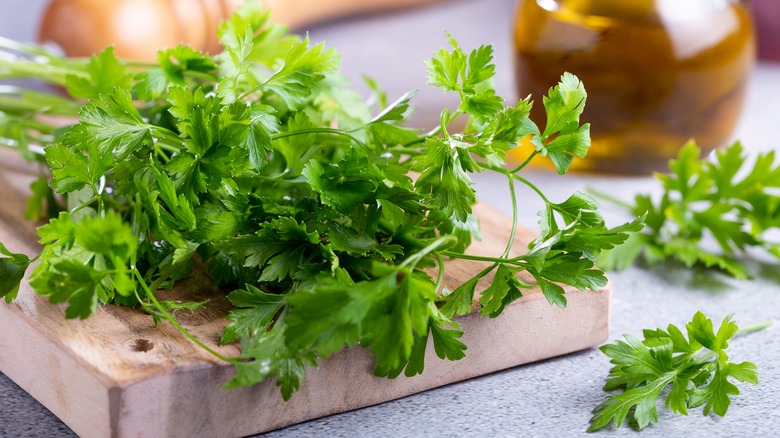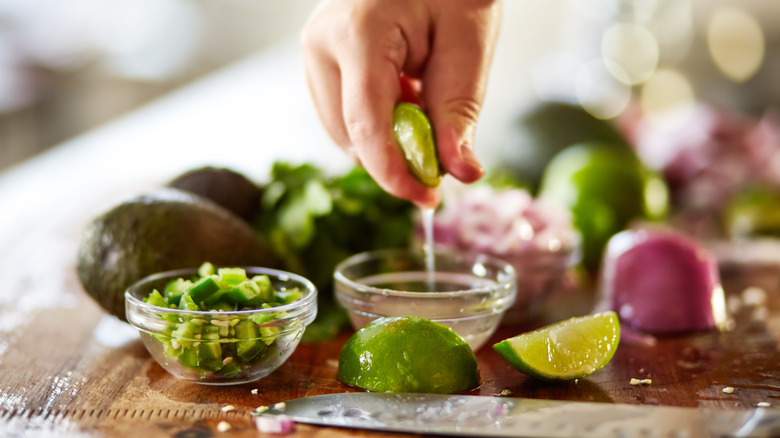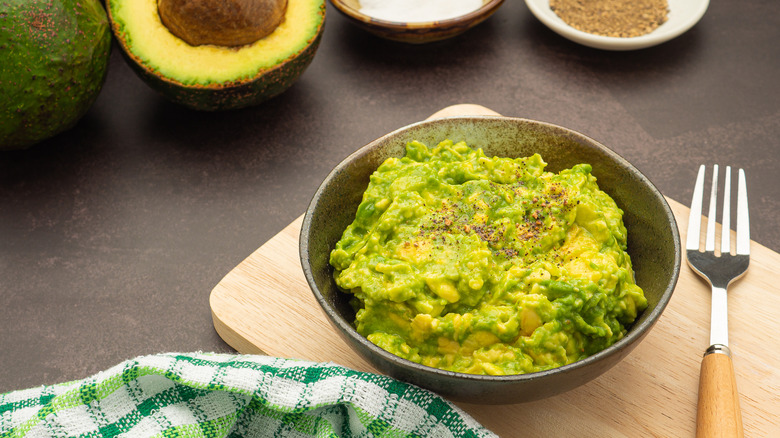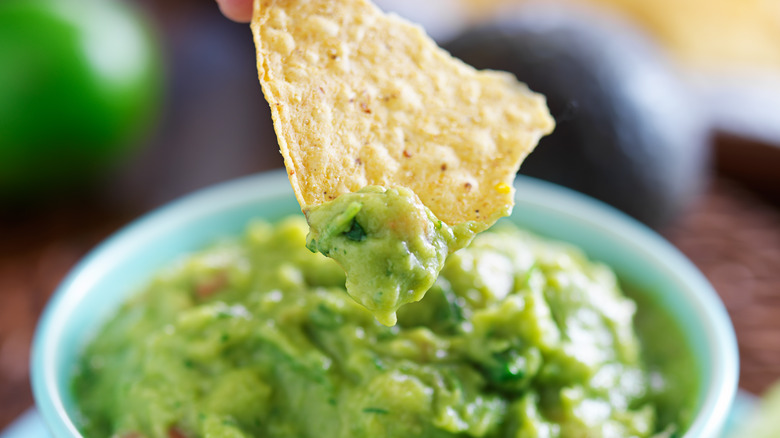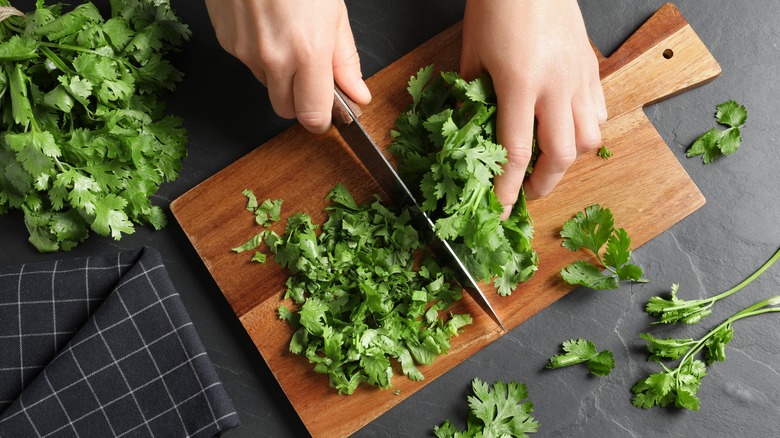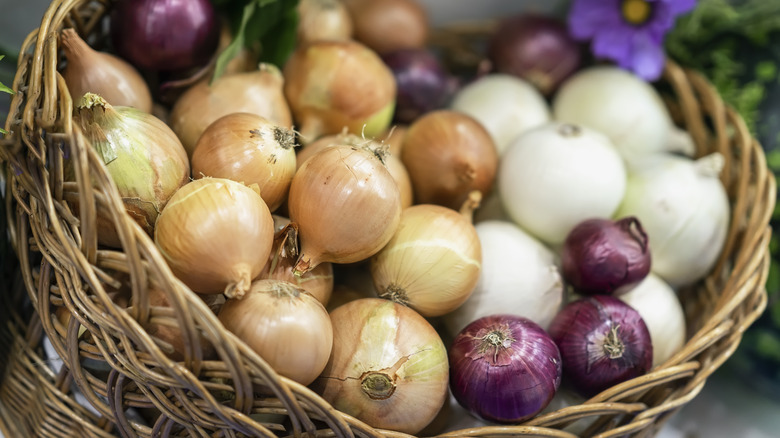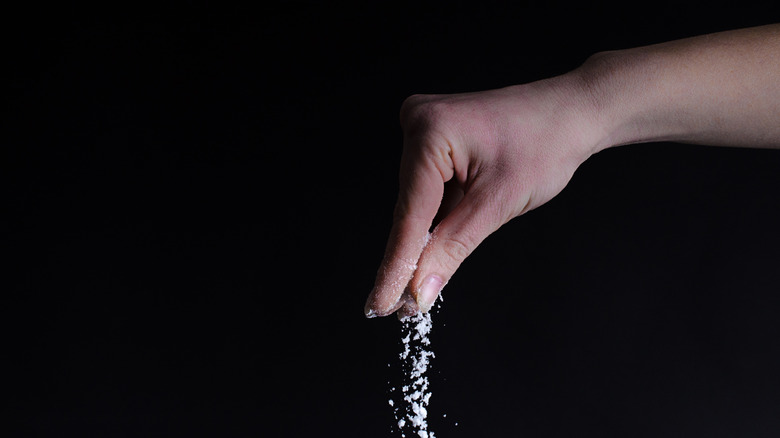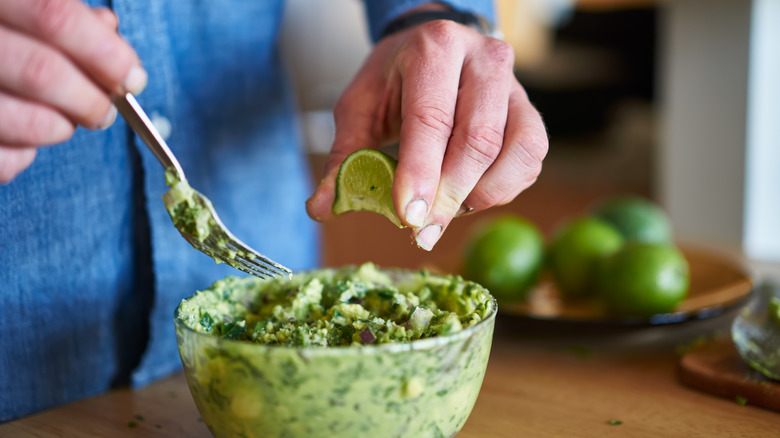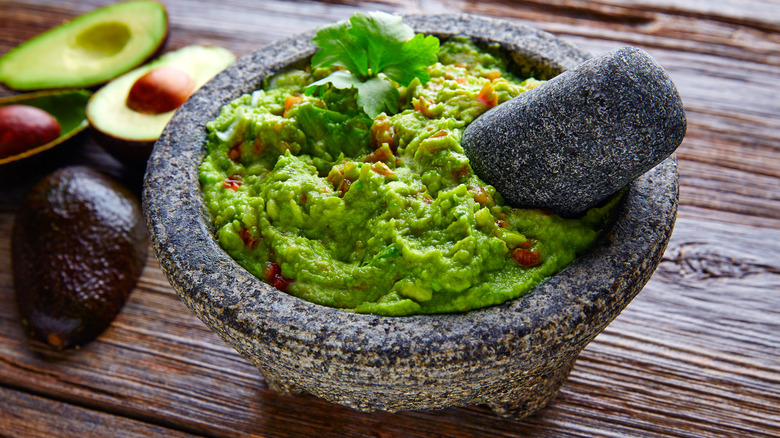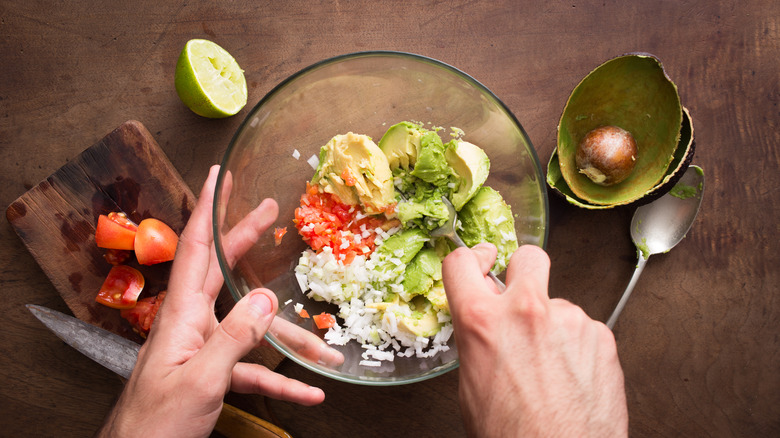15 Ways You're Ruining Your Homemade Guacamole
There's a reason we don't mind paying a little extra for a big old dollop of guacamole on our tacos or burrito bowls. The creamy and sometimes tangy topping is darn delicious on just about any savory dish and helps to balance the heat that's often found in Mexican cuisine. Its versatility in the culinary world is unmatched. What else can work so well as an appetizer, dip, spread, and topping all at once? Guacamole can vary incredibly in flavor, depending on the chef's desires and ingredients. But while no two guacamoles are created equal, following a few basic steps will help you avoid ruining your homemade guacamole no matter your recipe.
To make guacamole, a few core ingredients — like avocados, salt, and lime juice — are blended into a creamy paste, traditionally crafted using a mortar and pestle. Beyond that, chefs all over the world have gotten creative and added their own flair with additional ingredients, like tomato, onion, and garlic. Though this all seems fairly straightforward, a few missteps along the way can result in a stringy, brown, liquid pile of mush that nobody will want to dip their chip into. Here's how you can avoid ruining your homemade guacamole.
Choosing unripe avocados
Perhaps the biggest mistake people fall into when making their homemade guacamole is choosing an avocado that isn't quite ripe or one that has over-ripened. The memes about timing avocados perfectly are endless, and there's a good reason for this paranoia. It seems that one day you're dealing with a fruit that could be used as a baseball, while the very next day you might cut into a pile of mush encased in a shriveled shell.
If you're not confident in your avocado-selecting abilities, listen up. Chef Aarón Sánchez recommends buying an underripe avocado and ripening it at home until the fruit reaches perfection. Reach for green avocados that are firm and still have intact stems. Typically, avocados take a few days to ripen. Keep them out of the sun or store them in the refrigerator to slow the process.
If all of the avocados at your grocery store seem green and tough, don't despair. Look for ripened avocados at the bottom of the pile, as the natural gas the fruits release and which encourages ripening lingers in the depths of the pyramid. You may have to dig a little, but it could save you a trip to another store.
Forgetting to include lime juice
While lime juice is not entirely necessary, it gives guacamole a powerful zing that we've grown to love. Since avocados are so mild in flavor, the extra hit of taste provided by this citrus fruit can help bring them to life.
In addition to adding some pop to the already delicious dish, the acid in lime juice can also keep avocados looking fresh for longer. The green, fatty fruit oxidizes quickly, which means that it then turns an unpleasant brown color. This can be quite unappealing for guests hoping to plunge their chip into a fresh bowl of guacamole, even if you've only whipped it up a few hours before. Just a squirt of lime juice can do the trick to keep things looking right, but for those looking to create a truly bold tangy dip, consider using a bit more. Be sure to use the taste-as-you-go method to ensure your balance is just right.
Excluding olive oil
While avocados seem to have fats covered when it comes to guacamole, you'll find that some people just can't get enough of a good thing. While it's more common than you'd think to add mayonnaise to guacamole, we advise adding a splash of olive oil instead. This will not only improve the flavor but can help your guacamole last longer. Who knew that was even possible?
This flavorful oil complements avocados beautifully and has a secret superpower. The olive oil keeps air from making contact with the avocado, preventing the oxidation that browns the avocado. If you aren't a fan of adding oil to your recipe, consider at least using it to store guacamole so you won't have to worry about scraping off that brown layer on top later. To use this trick, simply spread your guac into a container and smooth down the top. Pour enough olive oil to completely cover the dish and cover it with a tight lid. Once you're ready to indulge again, pour off the layer of olive oil, mix up your guacamole, and enjoy your fresh, green guac.
Getting too fancy with ingredients
Spice is the variety of life, and we are all about experimentation when it comes to the culinary arts. Peanut butter on burgers? Give us a bite. Olive oil on ice cream? Tried it and loved it. Heck, we will even indulge in a slice of pineapple-heavy Hawaiian pizza now and again. But a line has to be drawn somewhere and usually, it's quite apparent when something has gone one step too far.
While guacamole has been known to host some seemingly odd but tasty ingredients, others leave us wondering why people can't just keep things nice and simple. For instance, bacon can enhance many savory and sweet dishes. But when it comes to guacamole, this cured meat is all wrong. While avocados and bacon might pair well on a sandwich, bacon bits aren't pleasant in a fatty mash. The chewy texture is off-putting, while many non-avocado ingredients in guac are meant to give you a break from the richness of the base. Other additions like cheese, seeds, and sour cream are a hard pass for similar reasons. Unless you've tasted it or can sample before committing, we recommend you start with the basics. Why mess with a good thing?
Chopping ingredients incorrectly
It's not just important to carefully select ingredients for your guacamole masterpiece, but you also want to be selective about how you prepare them. Ever scoop into a big bowl of guacamole only to be left with a mouthful of raw onion? Cutting ingredients like onions or tomatoes without a plan can result in ruined homemade guacamole.
While we love the addition in moderation, there's a reason we don't bite into onions as we do with apples. Chop onions so they are large enough to produce a crunch but small enough so that they won't end up overpowering the subtle flavors of avocado and will blend well with the entire mixture. Ideally, keep them the size of a corn kernel.
Meanwhile, tomatoes can become mushy quickly if prepared improperly. Consider dicing them into small chunks, but avoid any method that comes close to mincing. Slices tomatoes in half with a sharp blade and squeeze out the juice and seeds. Continue to dice until the cubes are about ¼ inch, about the same size as you would make them for pico de gallo.
Selecting ingredients that aren't fresh
Although it's always important to use fresh ingredients when cooking, it's all the more vital when making raw dishes, where you can't mask expired veggies and fruits. With its fresh preparation and lack of cooked ingredients, guacamole walks a fine line, so it's important to use only the best and freshest ingredients at your disposal.
While it's essential to choose a ripe avocado, there's more to guac than just its leading lady. If you've chosen to incorporate tomatoes, onion, and cilantro into your culinary creation then spring for the freshest you can get. Using cilantro paste or bottled lime juice can work in a pinch, but these come nowhere close to the real thing in terms of flavor. If you can get fresh, look for deep green cilantro without brown spots or dark patches, firm onions, and bright green limes.
If your limes are not producing the amount of juice that you'd like them to, try rolling them on the counter with a good amount of pressure to break up the juice pods inside. Of course, the fresh is best rule also applies to spices like cumin, black pepper, and cayenne. Try to get spices whole and process them at home, such as using a pepper grinder on whole peppercorns.
Making guacamole too far in advance
It's funny how some dishes, like coleslaw and soup, get better after sitting overnight, as the ingredients have a chance to infuse into each other and blossom. However, that rule does not apply across the board. With guacamole, the fresher it is, the better. This means that, if you're planning on having guests over for chips and dip, plan on making the guacamole right before they arrive. The appetizer is best at room temperature anyway and will save precious refrigerator space.
Why cut it so close? Consider the guac's color. Although oxidized, brown avocado is okay to eat, it's anything but appealing. Mixing your guac at the last second will ensure bright green goodness. It's best to not let the other ingredients like tomatoes sit too long in guacamole as well, because they may start to release liquid as they sit alongside salt. Play it safe by keeping things fresh.
Storing it incorrectly
When the party is over and you're left to pick up the paper plates, confetti, and half-eaten slices of cake, you know it's time for the Tupperware extravaganza. Although the bulk of your cleaning efforts might be spent trying to pair containers with lids, it's important to focus on how to properly store your guacamole. There's nothing worse than waking up to a big, brown container of expensive homemade guac, especially if you toss it a few days later.
One way to store cut avocados is to place raw onions in the same container. With guacamole, you're typically covered on the onion front, but if your recipe didn't call for any you can go ahead and throw a slice on top. In addition, try smearing the leftovers tightly into a container and smoothing the top. This leaves as little surface area as possible exposed to oxygen. Pour a thin layer of olive oil on it all and voila: a natural and delicious seal. Simply pour the olive oil off when you're ready to dive back in.
Not tasting it before serving
Part of the beauty of vegetables and fruit is that they are typically edible both raw and cooked. You wouldn't want to taste your chicken dish halfway through the cooking process, but feel free to take a spoonful of tomato sauce, vegan pancake batter, or guacamole to ensure that things are coming together. With guacamole, you can add a few squirts of lime juice or a dash of spice, mix it up, taste a spoonful, and consider whether or not you need to add more. Remember that you can always add more, but it's difficult to remove ingredients. If you do happen to overdo it with a spice or other add-in, consider throwing in an additional avocado and making a little extra guacamole.
Produce varies greatly in flavor, making this tasting process all the more important. While one lime might produce a tablespoon of juice, another might barely drip out half a teaspoon. Avocados taste different depending on the variety and how ripe they are. Cilantro can be more or less pungent depending on where it was grown. At any rate, the best part of being the head chef of your kitchen is doing little taste tests whenever you'd like. Enjoy the process!
Forgetting to add cilantro
While some people think that cilantro tastes like chemicals or soap, others can't imagine life without it. As it turns out, the soap flavor isn't a result of picky eaters or unrefined taste buds: it's actually partially genetic. So if you don't like the herb, skip along to the next section. But for those who can't get enough, listen up.
Yes, cilantro can be a bit of a hassle to prepare and store, but it's worth the effort when it comes to fresh, homemade guacamole. This herb has a fresh, citrusy flavor that complements the fatty neutral taste of avocados beautifully. Start by washing your cilantro with cold water, then gently drying it in a salad spinner or laying it on a paper towel to dry. Avoid bruising the herb or exposing it to too much heat. Use a sharp blade to chop it, and don't be shy about dicing up those stems as well. Be sure to mix it in at the last minute, as it doesn't need to be pulverized as avocados do.
Using the wrong onions
There are many varieties of onions out there, but which one is best to use in your guacamole? Well, as you probably already know, some onions are quite potent and shouldn't be eaten raw unless you're trying to wake someone from a coma. Otherwise, it's safe to stick to a milder, sweeter variety. And, no, we don't mean the red ones. Although many people use red onion in their guacamole, we usually find that variety to be too intense.
Instead, consider using sweet onions when it comes to chip's favorite dip. Sweet onions come in several varieties, but the kind you'll most likely stumble upon at the grocery store is the Vidalia variety. These contain quite a bit less sulfur than other onions. This is the compound that makes so many onions intensely pungent. If you think Vidalia onions might be too mild for your guacamole, don't fear, as they still bring a punch of flavor with each bite. Some tasters claim that this onion gives off sweet and spicy notes along with that crispy crunch that flawlessly breaks up the buttery mash of pulverized avocados.
Going light on the salt
When it comes to health, most Americans would be just fine if they reduced their sodium intake a little — or a lot. And while we do need salt to survive, as per the Harvard School of Public Health, most of us are getting quite an abundance of the compound. Yet, while there's a time and a place for low-sodium snacking, that generally doesn't apply when chips and guacamole are taking center stage. Use a chef's pinch of salt and bring home that phenomenal flavor of your homemade guac.
You might be wondering what a chef's pinch is, however. The truth is that it's a little heavier than you might expect. Instead of using your pointer finger and thumb to grab ahold of the tiny flakes, use a solid three-finger pinch. The heavy dusting will not only bring out the mild flavor of the avocados but will also help your other ingredients to pop. When it comes to seasoning, this is simply not the time to be shy. As always, be sure to taste test along the way and add more salt as needed.
Adding ingredients in the wrong order
Now that we've narrowed down which ingredients you'll be using in your guacamole creation, it's time to discuss the correct order in which to add them. Like when you're baking a cake, the order in which ingredients meet up really does matter. This isn't a one-bowl recipe free-for-all, so calm your horses.
Start by mashing your avocado. A mortar and pestle works best and is the traditional tool used to make guac, but sometimes it's just easier to grab a trusty fork and call it a day. Whatever implement you've got, use it to break up the larger chunks of avocado. If you've got a fork, press the flat back of the prongs into the flesh of the avocado until it's pulverized.
Next, use the fork to whisk the avocado until it's creamy and smooth. If you prefer to leave a few chunks in the mix, mix it all less thoroughly until you've reached your desired consistency. Then, add the lime juice and spices, and give it another solid mixing. Lastly, gently fold in any other ingredients such as onion, tomato, and cilantro. Avoid bruising the veggies and herbs by slowly mixing them until everything is just combined.
Overmixing your guacamole
If you're the type of home chef who is tempted to check on the pancakes every few minutes before flipping them or can't help but stir your mushrooms while they are browning, then you might want to pass your avocados off to someone who's a little less fidgety. Once your ingredients have been combined in the proper order, then it's hands-off until you have a chip in hand.
While it may be tempting to give your guacamole a few extra quick mixes before your guests arrive, it's better to just leave it as-is. Each time you mix it, you risk mushing, crushing, softening, and bruising your ingredients (besides the avocado which can take practically endless mashing). In addition, each time you stir the pot, you're introducing more oxygen to the guac, which may cause it to brown prematurely. So, if you feel the temptation, take a deep breath, take a step back, and drop your spoon.
Making it the same every time
The one thing you may notice about guacamole is its versatility. Seemingly everyone has a special ingredient or passed-down tip for making it the best it can be. When it comes to cooking overall, creativity is key. Although we may be creatures of habit, take the path less traveled and mix it up when it comes to guacamole. Although it is quite possible to ruin your homemade guacamole, don't let that hold you back too much. Remember that you have the liberty of tasting it as you go, which can prevent a major disaster.
Start by experimenting with hot sauces or powdered aromatics like garlic or onion. If you're enjoying the change, go a step further and include fruits like mango or pineapple (some people swear by it). There are plenty of variations out there, so perfect your basic formula and then add new ingredients from there. Who knows? You might just find something amazing.
